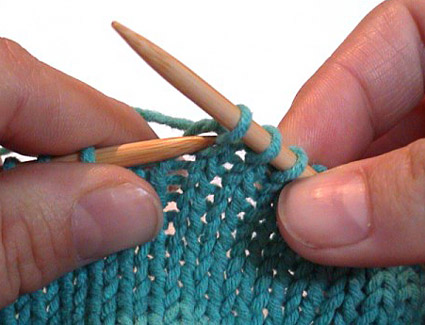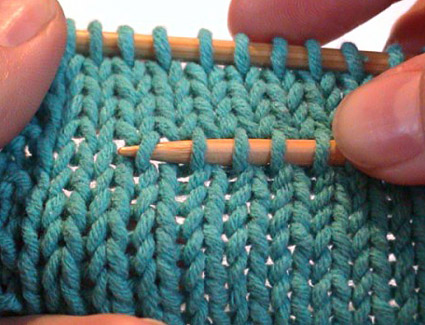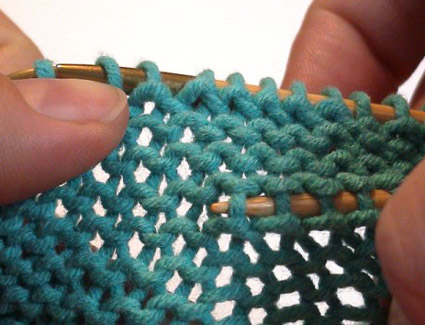Frog pond edition
In Japan, the kajika goes kerokero.
In Spain the rana sings cruá-cruá.
A beka would say bre-ke-ke in Hungary. Here in
Norway, frosker sier kvakk.
In the knitting world, however,
frogs say "rip it, rip it." And that's
the reason knitters use the term "frogging"
as they merrily unravel their hours worth of knitting.
Okay, it's not always a particularly fun thing
to do, especially if you've found a glaring error
and have to rip back something complicated like
fair-isle or lace. But it can be incredibly liberating
to admit that, well, this here just ain't working,
while posessing the sure knowledge that you have
the skill and talent to make something beautiful
out of a monstrosity. And if you really can't
bear to take your knitting apart alone, find a
friend [next door or on-line] and turn your trip
to the frog pond into a party!
The term frogging gives the
impression of a rather exuberant ripping out of
knitted stitches. But undoing your knitting stitch
by stitch - technically known as tink-ing [that's
"knit" spelled backwards] - can also
be a useful trick to master. It's quite easy to
be knitting along and realize you've gotten your
ribbing off one stitch during the particularly
exciting bit of that movie you're watching on
television. If you catch the error while you're
still on the same row...
insert the left hand needle
into the stitch just below the stitch on the right
hand needle....

...then slide the stitch onto
the left hand needle while pulling on the yarn
to release.

To unravel your work from a
purl side, do the exact same thing, keeping the
yarn in front. Repeat as many times as necessary
to get back to the stitches preceding the error.
The real challenge to your nerves
comes when you need to undo your knitting for
a few rows, but not back to bare yarn. If you
want to make life easier for yourself, try this
lovely trick:
Use either a knitting needle
[a smaller size might be a good idea here] or
a tapestry needle threaded with a spare length
of yarn... insert under the first loop of the
stitches all along the row below the error. Be
sure that you're staying in the same row as you
work horizontally across. The loop will be the
right half of the stitch both on a knit side...

...and on a purl side ::

The row that you've inserted
the needle [or thread] into will be the one you'll
start knitting on after you unravel the yarn.
To unravel just remove the working needle, take
a deep breath and pull...

The true joyous nature of frogging
is fulfilled when you can go wild while rippin'
it. Just remove the needles and pull the yarn,
winding it into hanks as you go along. Use a swift
if you're lucky enough to have one or wind the
yarn between your open hand and elbow, keeping
the tension on the yarn gentle and even. Be forewarned
that this ripping process is easier said than
done with fuzzy yarns or mohair that like to stick
together and is notoriously difficult to unravel.
You may find that the yarn is
curly and crimped, especially if it's been a while
since it was knit up. To return the yarn to knit-worthy
conditions, tie the hank in 3 or 4 places with
spare lengths of yarn and give it a gentle wash,
following the washing instructions from the yarn
label, using a small amount of mild soap and rinsing
well. Hang to dry over a rod, adding weights [whatever
you have handy, I usually use extra clothes hangers]
to gently pull the crimps out. When thoroughly
dry, rewind into skeins or balls and knit into
something wonderful!

